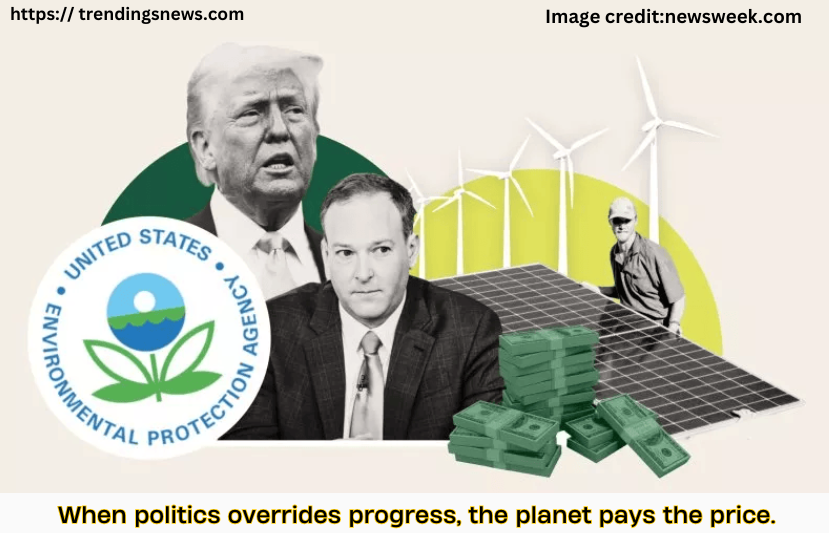Discover how the EPA Freezes Green Groups’ Accounts, halting $20 billion in climate action funding. Learn about the legal, political, and environmental impacts of this controversial decision.
The Environmental Protection Agency (EPA) has recently made headlines for its controversial decision to freeze the bank accounts of green groups involved in the Greenhouse Gas Reduction Fund (GGRF).
This move, described by legal experts as “highly illegal,” has sparked outrage among environmentalists, lawmakers, and communities reliant on clean energy projects.
The freeze directly impacts nearly $20 billion in federal funding aimed at combating climate change, raising questions about the Trump administration’s commitment to environmental justice and the future of clean energy initiatives in the United States.
What is the Greenhouse Gas Reduction Fund (GGRF)?
The GGRF is one of the most ambitious climate action programs in U.S. history, established under the 2022 Inflation Reduction Act.
With a total allocation of $27 billion, the fund aims to reduce greenhouse gas emissions and promote clean energy projects across the country. Key components of the GGRF include:
- Solar for All Program: A $7 billion initiative to expand rooftop and community solar power in low- and moderate-income communities.
- National Clean Investment Fund: A $14 billion program designed to finance large-scale clean energy projects.
- Clean Communities Investment Accelerator: A $6 billion fund to support smaller, community-based clean energy and energy-efficiency projects.
Managed by Citibank as the financial agent selected by the EPA and the Treasury Department, the GGRF has been a cornerstone of President Joe Biden’s climate agenda.
However, the recent freeze on accounts has thrown the program into disarray.
Why Did the EPA Freezes Green Groups’ Accounts?
Under the Trump administration, the EPA has taken drastic steps to halt funding for the GGRF.
EPA Administrator Lee Zeldin announced on February 13 that the agency intends to terminate its financial agent agreement with Citibank and recover the remaining funds.
Zeldin accused the previous administration of “irresponsibly wasting cash” and rushing to distribute billions of dollars before the 2024 election.
However, critics argue that the EPA’s actions are politically motivated and lack any evidence of wrongdoing.
David Super, a professor at Georgetown Law, called the freeze “highly illegal,” stating that the EPA failed to provide notice or an opportunity for recipient groups to respond before freezing their accounts.
The Impact of the Freeze on Clean Energy Projects
The freeze has had immediate and far-reaching consequences:
- Stalled Projects: Green groups and nonprofits involved in clean energy initiatives have been unable to access funds, leading to delays in critical projects.
- Employee Salaries: Organizations are struggling to pay their employees, creating uncertainty and financial instability.
- Disadvantaged Communities: Low-income families and communities already burdened by high energy costs and pollution are likely to suffer the most.
Former EPA consultant Jalen Hoover emphasized that the GGRF was designed to reduce energy costs and pollution risks for vulnerable populations.
Withdrawing funding now represents a “big, lost opportunity” to address climate change and promote environmental justice.
Legal and Political Backlash
The EPA’s decision has drawn sharp criticism from Democratic lawmakers and legal scholars.
Members of the Senate Committee on Environment and Public Works have accused Zeldin of making “false and misleading claims” to justify canceling a program already authorized by Congress.
A senior Justice Department lawyer resigned on February 18, citing concerns over the lack of evidence to support the freeze.
Dennis Cheung, the former head of the crime department, stated in his resignation letter that there was insufficient evidence to issue the order to freeze accounts.
The Broader Implications for U.S. Climate Policy
The freeze on GGRF funding is not an isolated incident but part of a broader pattern of climate policy rollbacks under the Trump administration.
Earlier actions, such as firing 500 employees at the National Oceanic and Atmospheric Administration (NOAA), have raised concerns about the administration’s commitment to addressing climate change.
This decision also has global implications. As the U.S. retreats from its climate commitments, other nations may follow suit, undermining international efforts to combat global warming.
Conclusion: A Critical Moment for Climate Action
The EPA’s freeze on green groups’ accounts represents a significant setback for climate action in the U.S. With nearly $20 billion in funding at stake, the future of clean energy projects and environmental justice hangs in the balance.
As the Trump administration continues to dismantle climate initiatives, the need for robust advocacy and legal action has never been greater.
The freeze on GGRF funding is not just a political issue but a moral one, with far-reaching consequences for communities, the environment, and the planet.
In the words of former EPA consultant Jalen Hoover, “This is a big, lost opportunity.” The fight for climate justice must continue, ensuring that programs like the GGRF are protected and expanded to meet the challenges of our time.

